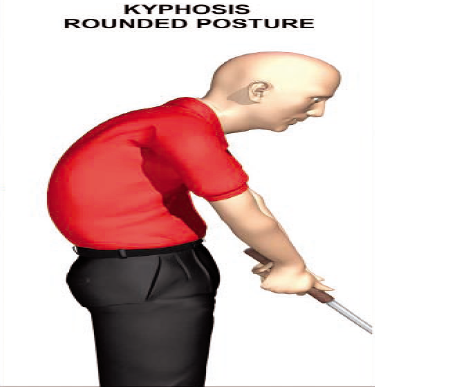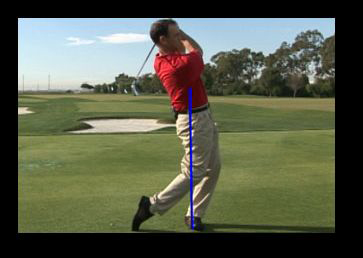No Results Found
The page you requested could not be found. Try refining your search, or use the navigation above to locate the post.
Improve Your Swing With Better Posture
In my last blog post I spoke about how you could test yourself to determine the areas of your golf fitness that needed to be improved. In this blog I am going to talk about the major problems that are seen in golfers from a posture point of view. I will then talk about some of the golf swing problems you may see as a result of these weaknesses.

Golfers also have a tendency to be short and tight in the muscles of the right, lower back (for right handers). This can be caused by the correct golf set up in which you have the left hip and shoulder set slightly higher than the right hip and shoulder. This may lead to the right side collapsing during the downswing and overactive hands through impact.
Another common body issue in golfers is weak scapular muscles. This is generally seen in conjunction with the rounded shoulders position I spoke about in the first point and can lead to a number a swing faults. Disconnection between the arms and body is the most common problem I see when a golfer is weak in the scapular area. This, again, leads to “armsy” type swings that I see on the lesson tee every day.

If you have had any of these types of swing problems, and you are having difficulty correcting them with your coach, there is a chance that you may have one of the postural issues I have spoken about. I would encourage you to go and see a golf specific physiotherapist/trainer for a detailed screening and have them design an exercise program for you. This, combined with the swing work you are doing with your coach, will give you the best possible chance to improve your swing and your game.
In my next blog I will be discussing some simple exercises you can do to help overcome some of the weaknesses I have discussed here.
Until next time,
Brent Davis

PGA Professional
Training & Education Coordinator
PGA Centre For Learning Performance
Melborne, Victoria, Australia
Email: [email protected]
The page you requested could not be found. Try refining your search, or use the navigation above to locate the post.
Never miss a new post, article, or video!
Subscribe to our newsletter Chip Shots!
Where Do You Start A Golf Fitness Program?
Mike Fay Golf welcomes Australian PGA Professional Brent Davis to the staff of talented writers. Brent’s knowledge of golf fitness and how it relates to the golf swing will be a great asset to the site. Below is his first post. Welcome, Brent!
I often get asked what exercises a player should do when they are working out in the gym. While it is important for golfers to get into the gym and exercise it is more important to be working out correctly if you want to improve your golf game.
There are different areas of fitness and each of these areas is important for golfers. The three areas of fitness are cardiovascular fitness, strength and flexibility. Cardiovascular fitness is important for being able to complete your round without fatiguing. Strength and flexibility is important for making a strong and powerful golf swing. Each of these areas should be addressed in a good golf fitness training program.
The first stage in any golf training should be an evaluation. You need to know your strengths and weaknesses so you can get the appropriate program for you. A good evaluation will also give you a starting point from which to measure your improvement. Measuring your improvement is also a great way to see if your program is appropriate and effective.
The next question then is how do you evaluate your current fitness levels? As a coach I use a number a different strategies to do this. Through my own research I have developed a series of evaluation tests that assess your ability to complete each test. This link will take you to a document that outlines the tests and how to complete them. You can then record your results and redo the tests after a set period of time. I like my students to complete the tests at the start of each macrocycle of their annual plan and you can determine the best timing for you with your own coach.
Another strategy I use, and this is arguably the best way to go about developing your fitness program, is to utilise expert service providers such as exercise physiologists and physiotherapists. Melbourne Golf Injury Clinic here in Australia has golf specific physiotherapists that will complete a entire body screening which will identify areas that need improvement. From this screening a personalised program can be designed to address the weaknesses. You can see a copy of this screening report by clicking on this link.
I also utilize a exercise physiologist to evaluate my client’s golf specific strength. He uses a series of tests to determine the areas that need to be worked on and from this can design the appropriate training program. He also has tour player benchmarks to compare yourself to and to aim for in your own training.
The purpose of this blog post is to give you an introduction into golf specific fitness training and to stress the importance of evaluating yourself before getting started. There will be plenty of people in your local area who you can talk to regarding your fitness programs. Check your local gym for sport specific trainers as well as online resources such as the TPI website and the Fitness for Golf website that you can find by clicking on the links provided.
Keep your eye on this website for more fitness articles.
Until next time,
Brent Davis

PGA Professional
Training & Education Coordinator
PGA Centre For Learning Performance
Melborne, Victoria, Australia
Email: [email protected]
How To Check Your Joint Range of Motion It is important in a good golf swing to be able to move with freedom and speed. Having a body that is capable of this type of movement means that more power can be generated and a more consistent and reliable swing can be...
Progressing Your Fitness Program The topic of this blog post is progression of your fitness program. One of the most common things I experience with my clients is that they sign up for a fitness program, go through an evaluation, get a written program tailored to...
Energy On The Course In my last post I spoke about the often overlooked part of a golf training program, recovery. Four areas were mentioned in the post and I promised that I would give you some strategies that you could use for each area to give you the best possible...
Never miss a new post, article, or video!
Subscribe to our newsletter Chip Shots!